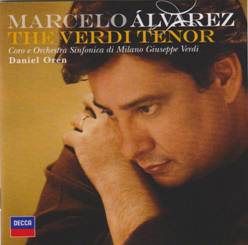Cond. Daniel Oren
Decca CD 478 1442

Marcelo Alvarez: The Verdi Tenor
Cond. Daniel Oren
Decca CD 478 1442

Whom are you thinking of when speaking about ‘The Verdi Tenor’ ? Some Americans will vote for Enrico Caruso; often older Englishmen still prefer Giovanni Martinelli. Most of us are too young to have heard that last gentleman in the flesh and anyway nobody will think of the recordings made after 1937 as exemplary for Verdi style. I bet there is a majority agreement that ‘The Verdi Tenor’ of the last 60 years is Carlo Bergonzi; though most will agree that Corelli was more exciting as Manrico, Del Monaco was great as Otello and even young Pavarotti was a winner with Il duca. So imagine my surprise when receiving for reviewing a CD just called that: ‘The Verdi Tenor’, signed Marcello Alvarez.
And by his first take, it is already clear that the tenor is anything but a true Verdi tenor. In “Celeste Aida” the singer painfully proves that he simply has not the vocal heft for Radames. This is the voice of a somewhat puffed up lirico without the strength to meet this challenge. Compare his version with the many recordings of the same aria made by other true lirico tenors like Pavarotti, Carreras or Gigli and you immediately notice that they nevertheless have the incisiveness and the breath to sustain the line; even though they are lacking the true colour. But even with the aid of modern technology, Alvarez takes a breath between “tu” and “sei regina”. Granted, this too reflects on sloppiness by conductor Daniel Oren and I cannot believe that Gianandrea Gavazzeni for Carlo Bergonzi or even Erede for Del Monaco would have allowed such carelessness. But Bergonzi and his predecessors and contemporaries knew the difference between mezza-voce, piano and outright crooning as Alvarez delivers here: a ploy that is simply inaudible without a mike in the theatre. The moment the real and taxing difficult morendo according to the score on the high B has to be sung, Alvarez prefers unremitting forte (Bergonzi and Corelli and even recently Botha proved they were able to sing the “vicino al sol” pianissimo in the house.)
The second track from Un Ballo reveals the same weaknesses. Alvarez is forcing and pushing an instrument lacking the vocal colours which is not the same as an amount of decibels. By this track too it is clear the tenor has no idea of the importance of the Verdi recitative. In Aida he simply shouts “per te ho pugnato” and the “Forse la soglia”-section of Ballo is not treated better. Alvarez proves he has no sense of Verdi style and phrasing; the music is simply belted out and this makes the contrast with some pianissimi in unexpected places more painful. This is even more clear in the “O fede negar potessi”part of the Luisa Miller aria which is painfully inadequate. One longs for the pure style of ….Mario Del Monaco’s Decca recording. Alvarez vocal problems are striking once again in the “L’ara o l’avello” cabaletta. The tenor just sputters and guffaws away. One notices too his lack of a real trill in “Ah, si ben mio”; just a short shake. With “La mia letizia” from I Lombardi one suddenly sits up. This is the kind of music the voice is better suited to. In Ernani there is real ardour without stylishness and it is clear that a recital devoted to late Donizetti or young Verdi is the kind of music where the strength of Alvarez lies. In these pieces he clearly feels more at ease and therefore can sing with a greater respect for legato. But the moment he goes to the heavier parts like Don Carlo he is in difficulties again and no copying of Pavarotti’s equally inadequate performance will help. Nowadays the dearth of real Verdi tenors is indeed a problem but it will not be solved by recording firms asking a lyric tenor (or even a pop singer like Bocelli) to step in shoes far too big.
Jan Neckers